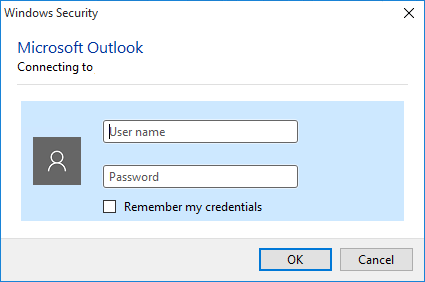While connecting the Outlook client to the Exchange Server, you may get a prompt for the username/password. It is a windows security alert which stops you from accessing your account.

This error happens when:-
- Users are using Exchange server 2016 and 2013 in a co-existence environment (with legacy versions like Exchange Server 2010 or Exchange Server 2007).
- Users are trying to use Outlook Anywhere to connect their Exchange Server 2010 or Exchange server 2007 mailboxes.
- Mailboxes are connected through Exchange 2016 Client Access Server or 2013 Client Access Server.
Manual Method
Here are all possible solutions which you can try to remove the error –
- Enable Kernel-Mode Authentication for Autodiscover and EWSTo enable the Kernel-Mode Authentication, follow the steps –
- Log on to Exchange 2013 CAS Server and open IIS 7.0.
- Browse virtual directories for Autodiscover and EWS.
- Select EWS, then select authentication.
- Set the status of Anonymous authentication to Disabled.
- Go to Windows authentication and then click Advanced Settings.
- Select Enable Kernel-mode Authentication and then click OK.
- Follow the same procedure for Autodiscover.
- Initiate Exchange Management Shell and run the command –
- Finally, restart the Outlook application.
IISRESET - Change the default Application pool run account to ‘Network ServiceTo change the default application pool run account –
- Follow Start>>Program>>Administrative Tools>>Internet Information Services (IIS) Manager.
- In Internet Information Services Manager, expand the local computer, and then expand the Application Pools.
- Select any Application pool, right-click it and click Properties.
- In the account’s properties dialog box, go to Identity tab and change the Predefined value to Network Service.
- Move the Arbitrary MailboxHere is the process of moving the arbitrary mailbox –
- Find all Arbitrary mailbox in a database –
- Move arbitrary mailbox from one database to another database.
- Assign OAB for all database
Run the following command to assign OAB –Get-MailboxDatabase -Server Exchange 2010 | Set-MailboxDatabase -OfflineAddressBook ‘Default Offline Address Book’After completing all troubleshooting processes, try to verify all your previous activities –
- Verify the status of EWS and Autodiscover.
- Verify the value of the default application pool run account.
- Verify that you have moved the arbitrary mailboxes.
Get-Mailbox -Database | Get-Mailbox -Arbitration | ft name, database, servernameGet-Mailbox -Database “DB0213” -arbitration | New-MoveRequest -TargetDatabse “DB221”
Any other migration-related issues?
At the time of migrations, Exchange administrators face a lot of issues. That is why professional tools are chosen for complex migrations. Exchange Migrator is one such an Exchange Migration tool which can migrate mailboxes from one Exchange Server to another with complete data. It fully protects your mailbox data and migrates them to the specified destination.

